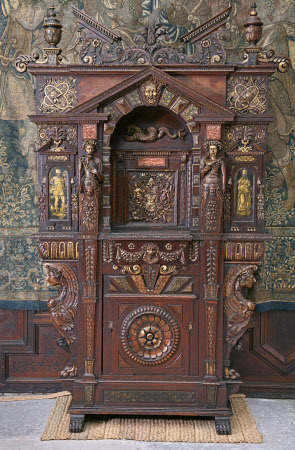Hardwick Hall's so-called 'du Cerceau' Cabinet - circa 1570
after Jacques Androuet Du Cerceau (c.1515 - c.1584)
Category
Furniture
Date
circa 1570
Materials
Carved and painted walnut and oak, parcel-gilt and marble-inlaid, on an oak carcase, with gilt and silver paintings on leather
Measurements
237.5 x 140 x 40.8 cm
Place of origin
Paris
Order this imageCollection
Hardwick Hall, Derbyshire
NT 1127743
Summary
A rare carved, painted, parcel-gilt and marble-inlaid oak and walnut cupboard, with gilt and silver grisailles on leather, probably Paris, circa 1570, incorporating motifs after designs of Jacques I Androuet du Cerceau (1510 - 1584), probably at Hardwick before 1601, but possibly previously at Chatsworth. Compressed wood shavings also used as decoration. Of architectural form, and topped by a broken pediment between urns on pedestals, all above a further pediment formed from a reticulated arch and a niche cupboard door, carved with military trophies and beneath an applied giltwood sea monster (possibly later or re-located), flanked to either side by a figural term, and two further bays filled with monochrome paintings of gilt and silver grisaille on leather of Mars and Minerva, each above a shelf (also later) supported on a profile term of a winged woman or harpy with a lion's paw foot, all flanking a drawer carved with a mask between drapes above a cupboard door carved with a large foliate roundel. Raised on probably later paw-carved sledge feet. Decorated in colours (much of which appears to be original) and with further decoration of inset marble plaques and faux marble painted areas. Elements of decoration, i.e. to either side of the pediment above the central niche, lacking. .
Full description
Usually identified with 'a Cubberd with tills Carved and guilt, a Carpet for it of needlework with gold fringe lined with Crimson taffety sarcenet' in the inventory of 1601, but this is doubtful, as the cabinet's drawers are not its most prominent feature, and it is too high to accommodate a decorative carpet. The harpy terms flanking the cabinet's base are clearly derived from a du Cerceau plate. Other similarities between this cabinet and the 'sea-dog' table [NT 1127744], such as the carving to the central drawer front, suggest that both may have come from the same source. Possibly Mary, Queen of Scots, in the charge of the Earl of Shrewsbury between 1568 and 1584, was involved in their acquisition. Virtually all of the motifs on the cabinet can be paralleled in prints by Du Cerceau. Dendochronological analysis published in January 2016 found that French oak (both slow and fast growing) which cannot have been felled before 1540 was used in the construction of this cabinet.
Provenance
By descent until, following the death of Edward William Spencer Cavendish, 10th Duke of Devonshire (1895 - 1950), Hardwick Hall and its contents were accepted by HM Treasury in part payment of death duties and transferred to the National Trust, in 1959.
Makers and roles
after Jacques Androuet Du Cerceau (c.1515 - c.1584), designer
References
Jervis, Simon Swynfen, 'Furniture at Hardwick Hall - I' in Hardwick Hall: A Great Old Castle of Romance, eds., David Adshead and David Taylor (2016), 90 - 95 Boynton and Thornton 1971 Lindsay Boynton and Peter Thornton, ‘The Hardwick Inventories of 1601’, Journal of the Furniture History Society, Vol.VII, 1971, p. 27 Bostwick, 1995: David Bostwick. “The French walnut furniture at Hardwick Hall.” Furniture History 31 (1995): pp.1-6. Erlande Brandenburg et al. (2001), Hugues Sambin: Un createur au XVI siècle (vers 1520 - 1601), Paris (2001) Jourdain 1927, Margaret Jourdain, 'French Renaissance Furniture at Hardwick Hall', Country Life, April 30th 1927, lv - lix. National Trust (Great Britain), Hardwick Hall., 1994, p. 70
